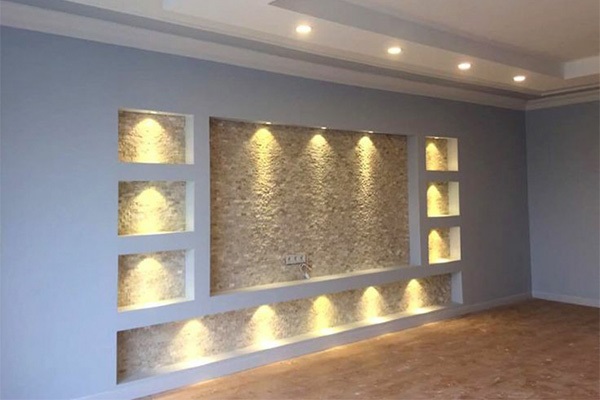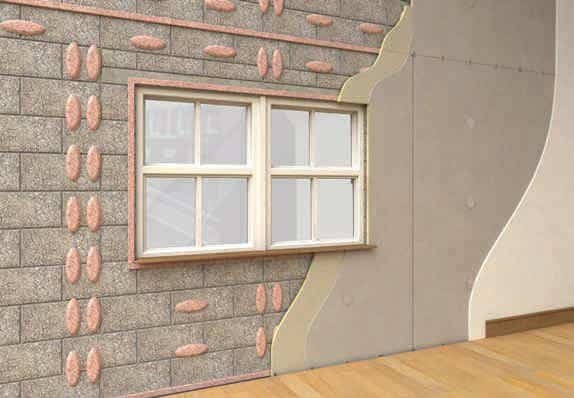Cladding walls are one of the key components in modern architecture and construction, especially in the finishing and renovation of buildings. Due to their unique features, these walls are widely used to improve sound insulation, thermal insulation, and the structural integrity of buildings. In this article, we will explore the different types of cladding walls, their applications, and their benefits, and ultimately, we will invite you to shop at Banasan.

What is a Cladding Wall?
A cladding wall refers to a structure that is used to enhance the physical properties and aesthetic appeal of walls. These structures can replace plaster and mortar, serving as finishing and surface treatment in buildings. Cladding walls are generally categorized into two main types: structural and non-structural, and can be designed to provide thermal and sound insulation, as well as structural reinforcement.
Types of Cladding Walls
Cladding Walls with a Frame Attached to the Base Wall
In this type of wall, gypsum board panels are installed on a metal framework attached to the base wall. These structures are particularly suitable for uneven or problematic walls and allow for the passage of electrical and mechanical installations without the need for channeling. These cladding walls are also highly practical for covering shear concrete walls, where other methods may face limitations.
Cladding Walls with a Standalone Frame
These cladding walls are similar to partition walls, where panels are installed on just one side. This structure is ideal for walls in poor condition, walls taller than 3 meters, or in cases that require fire resistance. Additionally, standalone cladding walls are widely used in the restoration and renovation of historical buildings.
Cladding Walls Without a Frame
These walls are attached to the base wall without requiring a metal frame, using specialized adhesives instead. This type of cladding is quick and efficient, best used on smooth, strong, and unpolluted walls. Since these cladding walls do not require additional space, they are also suitable for areas with limited space.
Applications of Cladding Walls
Improving the Physical Properties of a Building
One of the primary applications of cladding walls is to enhance the physical features of buildings. These walls can create better sound and thermal insulation, helping reduce energy loss.
Architectural Coatings and Aesthetics
In addition to their technical applications, cladding walls also play an essential role in enhancing the interior aesthetics. These walls can provide a modern and elegant finish to a building's interior as an architectural coating.
Restoration and Renovation of Masonry Walls
Cladding walls are particularly useful for the restoration and upgrading of old or damaged walls. By using cladding walls, masonry walls can be effectively repaired and improved, addressing issues such as moisture and cracking.
Benefits of Cladding Walls
Enhanced Sound and Thermal Insulation
Cladding walls, with their insulating properties, significantly improve the thermal and sound insulation of buildings. These features enhance comfort and well-being within the interior of a building.
Speed and Efficiency in Installation
One of the major advantages of cladding walls is their quick installation. These walls are easy to install, and do not require long drying times or complicated procedures.
Ease of Repair and Maintenance
Cladding walls are simple to maintain due to the easy access to installations and repairs. If any repairs are needed, accessing the utilities beneath the wall is far simpler compared to traditional walls.
Cladding Walls in Restoration and Renovation Projects
Cladding walls play a crucial role in renovation and restoration projects. In historical or old buildings with damaged masonry walls, using cladding walls can help restore interior walls without damaging the original structure. This method is especially effective in protecting old walls from environmental changes and physical damage. For example, in restoration projects of historical buildings, using cladding walls with a standalone frame allows for the creation of a protective layer without direct contact with the original wall.
Impact of Cladding Walls on Reducing Energy Costs
The use of cladding walls can significantly reduce energy costs in buildings. Due to their thermal and sound insulating properties, these walls can prevent energy loss. For example, in cold seasons, cladding walls help retain heat inside the building, while in warmer seasons, they prevent heat from entering. This feature not only reduces heating and cooling costs but also provides greater comfort for occupants and creates a more pleasant environment.
Diverse Designs of Cladding Walls
A standout feature of cladding walls is their ability to adapt to various architectural styles and interior designs. With these walls, highly diverse and beautiful designs can be created in different spaces. In addition to their technical functionality, cladding walls serve as decorative elements in the building's interior. From painting and wallpapering to the use of special coatings, cladding walls provide interior designers with the flexibility to create spaces that are both attractive and in line with various tastes.
Steps for Installing Cladding Walls
To install cladding walls, the type of wall and desired structure must first be chosen. In this stage, necessary substructures are prepared, and gypsum or composite panels are installed on them. If necessary, electrical and mechanical installations are also placed in the gap between the cladding wall and the base wall. Once installed, the joints are filled with special putty, and the surface is ready for painting or other coatings.
Situations for Using Cladding Walls
Cladding walls have a wide range of applications in various projects, including residential, office, commercial, and industrial buildings. These walls can be used in the renovation of old buildings, concrete walls, tall buildings, and even in historical building restoration projects.
Cladding Walls and Improving Quality of Life
Cladding walls not only help improve the structural quality of buildings but also have a significant impact on the quality of life for residents. Thanks to their soundproofing and thermal insulation features, these walls can reduce external noise and sound interference inside the home, which contributes to greater peace and comfort within interior spaces. Moreover, since cladding walls can also act as thermal insulators, they help maintain the interior temperature at comfortable levels and prevent energy loss. These qualities make living in buildings equipped with cladding walls more comfortable and cost-effective.
Choosing the Right Materials for Cladding Walls
One of the key factors in the performance of cladding walls is selecting the right materials for their structure. While cladding walls can be made from a variety of materials, using high-quality materials can significantly impact their durability and performance. For example, using moisture-resistant and pollution-resistant gypsum panels can increase the longevity of the walls and reduce the need for repairs and maintenance. Additionally, selecting panels with sound and thermal insulation properties can improve the effectiveness of cladding walls and lead to significant improvements in the building's environmental conditions.

Conclusion
Ultimately, cladding walls, as one of the modern technologies in construction, offer numerous benefits that can improve the quality, comfort, and aesthetics of buildings. These walls are an excellent option for various construction projects due to their unique features.
To explore various types of cladding walls and purchase them, visit Banasan’s website and benefit from high-quality products and excellent services.
We invite you to shop at Banasan! If you are looking for high-quality cladding walls with global standards, Banasan's website is the best option for you. Visit the site, benefit from expert consultations, and easily purchase the products you need.